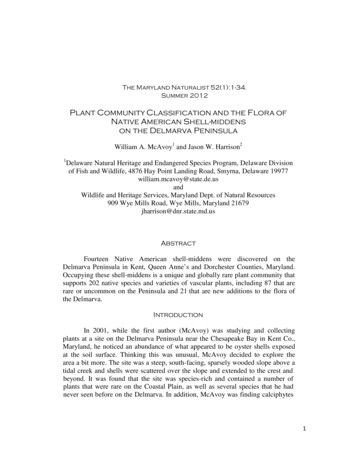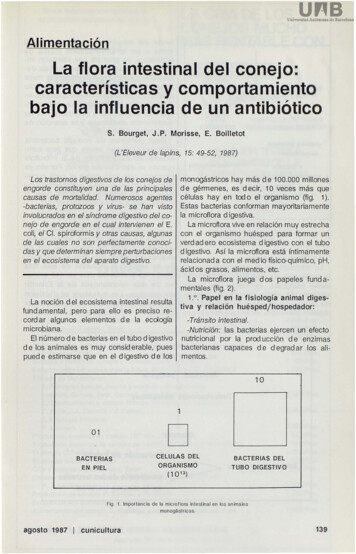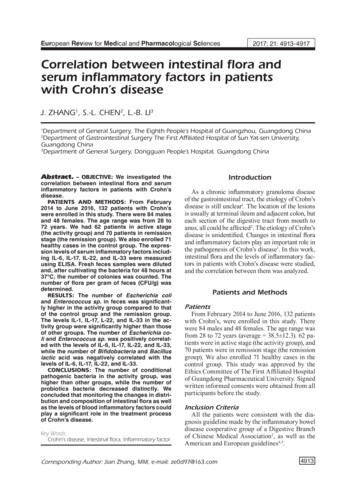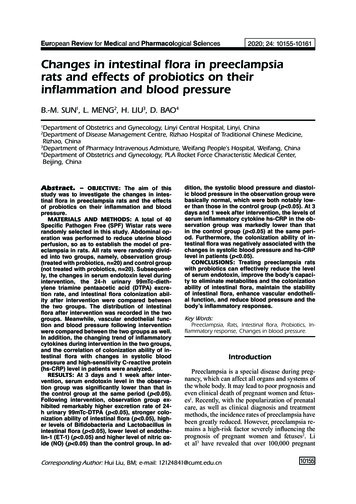
Transcription
The Maryland Naturalist 52(1):1-34.Summer 2012Plant Community Classification and the Flora ofNative American Shell-middenson the Delmarva PeninsulaWilliam A. McAvoy1 and Jason W. Harrison21Delaware Natural Heritage and Endangered Species Program, Delaware Divisionof Fish and Wildlife, 4876 Hay Point Landing Road, Smyrna, Delaware 19977william.mcavoy@state.de.usandWildlife and Heritage Services, Maryland Dept. of Natural Resources909 Wye Mills Road, Wye Mills, Maryland 21679jharrison@dnr.state.md.usAbstractFourteen Native American shell-middens were discovered on theDelmarva Peninsula in Kent, Queen Anne’s and Dorchester Counties, Maryland.Occupying these shell-middens is a unique and globally rare plant community thatsupports 202 native species and varieties of vascular plants, including 87 that arerare or uncommon on the Peninsula and 21 that are new additions to the flora ofthe Delmarva.IntroductionIn 2001, while the first author (McAvoy) was studying and collectingplants at a site on the Delmarva Peninsula near the Chesapeake Bay in Kent Co.,Maryland, he noticed an abundance of what appeared to be oyster shells exposedat the soil surface. Thinking this was unusual, McAvoy decided to explore thearea a bit more. The site was a steep, south-facing, sparsely wooded slope above atidal creek and shells were scattered over the slope and extended to the crest andbeyond. It was found that the site was species-rich and contained a number ofplants that were rare on the Coastal Plain, as well as several species that he hadnever seen before on the Delmarva. In addition, McAvoy was finding calciphytes1
(plants that do not tolerate acidic soil), such as wild columbine (Aquilegiacanadensis), large-seed forget-me-not (Myosotis macrosperma), bottlebrush wildrye (Elymus hystrix var. hystrix), smooth rockcress (Boechera laevigata var.laevigata), redbud (Cercis canadensis var. canadensis), Eastern hop-hornbeam(Ostrya virginiana), and yellow chinquapin oak (Quercus muehlenbergii). Later,McAvoy studied maps of this region of Kent County hoping to find additionalsites. Several more sites were found all having a similar suite of plant species andthe same physical features (steep slope above a tidal creek and shallow drysoils with oyster shells exposed at the surface). At this point, McAvoythought it would be wise to inform Jason Harrison (second author), ecologist forthe Maryland Wildlife and Heritage Services of what had been found, so thatthe plant community could be properly classified.From 2001 to 2009, we searched for new sites on the various ChesapeakeBay tributaries of Kent, Queen Anne’s and Talbot Counties, Maryland, and a totalof 14 sites were documented and classified, including one site in Dorchester Co.,Maryland. We initially thought that this plant community may have developed onlate Paleocene [58 to 55 million years before present (MYBP)] marine deposits ofthe Aquia Formation. The Aquia Formation, developed during sea-level pulses,consists of clays, silts, shells, and glauconitic sands and is randomly exposed, ornear the surface, in a continuous arc from the upper Chesapeake Bay to the JamesRiver in Virginia (Ward & Powars 2004). However, after reviewing geologicmaps it was concluded that only one of our 14 sites correlated with the AquiaFormation, thus refuting our original hypothesis. Shell samples were provided toJohn Wilson of the Maryland Geological Survey in Baltimore, Maryland, whoconcluded that the shells are “of modern origin and too young to be from thePaleocene” and they are more likely from Native American shell-middens.Following a recommendation from Charles Hall of the Maryland Historical Trust,Darrin Lowery, a geoarchaeologist with the Smithsonian Institution wasconsulted. After describing the sites to Lowery and making field visits to severalknown areas, Lowery confirmed that these sites are indeed Native Americanshell-middens that could be over 3,000 years old and explained that NativeAmerican populations on the Delmarva Peninsula gathered shellfish from theChesapeake Bay for food. These people cooked and ate their harvests on adjacenthigh-ground, then discarded the shells which led to the formation of the middens(pers. comm. Lowery 2009). The word “midden” has its roots in the Scandinavianlanguages, meaning an accumulation of refuse about a dwelling place (Stein1992). Large shell-middens containing oyster, soft-shell clam, razor clam, hardshell clam, ribbed mussel, bay scallop, and whelk have been documented around2
the shorelines of the Delmarva Peninsula (Lowery 2005). Thousands of shellmiddens may have once existed, but sea level rise, shoreline erosion, mining, anddevelopment have eliminated, destroyed or degraded many of these uniquearchaeological features (pers. comm. Lowery 2011).Perhaps the first account of shell-middens on the Delmarva comes fromDucatel and Alexander (1834), who submitted a report to the Maryland House ofDelegates, noting that “extensive accumulations of oyster shells, evidently madeby the aboriginal inhabitants of the country [were found], and that “extensiveaccumulations of this kind are said to be met with at Worton Point on theChesapeake Bay in Kent County.” Jordan (1906) explored shell-middensconsisting of the “common oyster” on Still Pond Creek (Queen Anne’s Co.) andestimated them to be “1000 years of age.” In 1938, Moorehead et al. reportedfinding “shell-heaps” in Kent Co. on Still Pond Creek, Worton Creek, and FarleeCreek [today known as Fairlee Creek (Moorehead et al. 1938)]. Moorehead et al.(1938) also pointed out that, “The situation of Indian shell-heaps on theChesapeake Bay and its estuaries was probably determined in respective cases bythe nearness of oyster bars. It seems likely that the Indians of those parts rarely, ifever, transported their oysters to shores very distant from the bars on which theyobtained them.”This paper examines the ecological and botanical components of NativeAmerican shell-middens on the Delmarva Peninsula and describes the plantcommunity and flora that now occurs on these ancient and fascinating features.The Study AreaThe Delmarva Peninsula (Fig. 1), is an area lying entirely within theAtlantic Coastal Plain physiographic province of the eastern United States. ThePeninsula lies south and east of the fall line (a term applied to the boundarybetween the Appalachian Piedmont province and the Atlantic Coastal Plain) inNew Castle County, Delaware, and Cecil County, Maryland, and is bordered onthe east by the Delaware River, Delaware Bay and the Atlantic Ocean, and on thewest by the Elk River and Chesapeake Bay. It includes the Coastal Plain provinceof Delaware (New Castle, Kent, and Sussex Counties), the Eastern Shore ofMaryland (Cecil, Kent, Queen Anne’s, Caroline, Talbot, Dorchester, Wicomico,Somerset, and Worcester Counties), and the Eastern Shore of Virginia (Accomack3
Fall LinePiedmontNewCastleCecilEastern - WesternShore Boundary e 1. Location map for the Delmarva Peninsula.and Northampton Counties). Its length north to south is about 200 miles (320 km),its greatest width is about 70 miles (110 km), its narrowest width is about 10miles (16 km), and the total land area is about 5,800 square miles (15,000 squarekilometers). The climate of the Peninsula is moderated by the Delaware Bay,Chesapeake Bay, and the Atlantic Ocean and is characterized by cool winters andwarm, humid summers. The landscape of the Delmarva is mostly rural, on flat to4
gently sloping sandy plains with slow-flowing rivers and streams that arebordered by extensive swamp forests and tidal marshes. In the coastal areas,barrier islands, salt marshes, tidal flats and inland bays are well developed. TheDelmarva’s Coastal Plain soils of sands, silts, clays and gravel support forestsprimarily composed of mixed evergreen [Pinus taeda (loblolly pine), Ilex opacavar. opaca (American holly)] and deciduous tree species [Quercus spp. (oaks),Carya spp. (hickory’s), Fagus grandifolia (American beech), Nyssa sylvatica(black gum), Liquidambar styraciflua (sweet gum), Acer rubrum (red maple), andLiriodendron tulipifera (tulip poplar)]. The Delmarva Peninsula lies within theChesapeake Bay Lowlands Ecoregion as defined by The Nature Conservancy(2002), and within the Outer Coastal Plain Mixed Forest Province as mapped byBailey (1995).MethodsThe flora was inventoried qualitatively at 14 shell-middens throughout thegrowing seasons of 2001 to 2009 in an effort to capture the full floristiccomposition (Appendix I). All taxa (species, subspecies and varieties) wererecorded from each shell-midden sampled. In addition, the frequency ofoccurrence for each taxon, or the number of shell-middens each taxon wasrecorded from was tallied (Appendix I). Source of botanical nomenclature followsWeakley (2010). In addition, quantitative data were collected from vegetationplots established at three sites using the Relevé method (sensu Peet et al. 1998),following guidelines used by the Maryland Natural Heritage Program to classifyvegetation to the United States National Vegetation Classification (NVC).Sample sites were chosen subjectively by the authors to represent areasreasonably uniform in physiognomy, floristic composition, and environment.The physical characteristics, including soil types, soil moisture regime,soil drainage class, surface substrate, aspect, topographic position, and slopeshape of each site were measured to gain an understanding of the range ofenvironmental variables that allow these unique communities to persist.Elevation was measured to the nearest 10 ft ( 3 m) using USGS 7.5 minutetopographic quadrangles. Soil surveys (Matthews et al. 1966; White 1982; NRCS2011) of Kent, Dorchester, and Queen Anne’s Counties, Maryland were used todetermine which soil series and associations occurred at each site. A total of tensoil samples were collected from four sites and sent to Brookside Laboratories in5
New Knoxville, Ohio, for nutrient chemical analysis using the Mehlich III method(Mehlich 1984). General soil characteristics such as color and texture wereevaluated in the field. Geological information was obtained through GIS softwareand consultations with geologists of the Maryland Geological Survey.Plant Community ResultsPhysical CharacteristicsSurveys conducted throughout the growing seasons of 2001-2009identified 14 sites on the Delmarva Peninsula that support a unique vegetationconsisting of calciphytes (see Botany Discussion below) and several regionallyrare and uncommon species (see Botany Discussion below). Sites documentedwere found on dry, steep slopes and bluffs, contiguous uplands, and spits that wereall adjacent to tidal tributaries and the main stems of rivers of the upperChesapeake Bay. Nine of the 14 sites are located in Kent County, four in QueenAnne’s County, and one in Dorchester County (Table 1). The sites identifiedoccupy small irregular patches ranging from 0.16 ha (0.4 ac) to 7.8 ha (mean 1.8 ha [4.4 ac]) in size. Overall, the 14 sites cover an area totaling 24.9 ha (61.4ac). Slope aspects are variable among sites with seven oriented to the south,five oriented to the north, and two sites with multiple aspects because of itsposition on small, narrow spits near the mouths of tidal creeks. The majority ofvegetation is best developed on slopes with convex slope curvatures (i.e., vertical)at mid to upper positions ranging in elevation from 2-7m ( 6-22 ft) above sealevel (USGS 1973-1986). Percent slope among study sites varied widelydepending on landform (e.g., spit), topographic position, and proximity to erosivetidal action. Side slopes immediately adjacent to tidal tributaries are very steepranging from 58-74% and often displayed visible evidence of mechanical erosion.Sites positioned near the proximal end of spit landforms or contiguous landwarduplands, are characterized by more gentle, undulating topography. Clinometermeasurements of slope in these settings ranged from 8-30%.We reviewed site locations and digitized versions of the 1968 geologicmap of Maryland (Cleaves et al. 1968) in ArcGIS 9.2 (ESRI 2006) to determinesurficial geology (Table 1). Due to the spatially coarse nature of these data, othersources were used in conjunction to ascertain geology for each site. Countygeological surveys (Miller et. al 1926), maps (Owens and Denny 1986; Miller et.al 1915), and personal communication with Maryland Geological Surveygeologists, verified the geology for the remaining sites. In addition, a detailed6
discussion of regional stratigraphy for the Betterton quadrangle, Kent CountyTable 1. Locality, County, Number of Sites, and Geologic Formation (Cleaves etal. 1968) of shell-midden sites sampled on the Delmarva Peninsula from2001 to 2009.NameCountyHowell PointStill Pond CreekChurn CreekWorton CreekFairlee CreekChester RiverSoutheast CreekTransquaking RiverKentKentKentKentKentQueen Anne’sQueen Anne’sDorchesterNo. sites23221121Geologic FormationLowland DepositsMagothy FormationPotomac GroupLowland DepositsLowland DepositsLowland DepositsLowland DepositsLowland Deposits(Minard 1974) provided us with information for sites at Howell Point and StillPond Creek. Through these sources we determined that sites at Howell Point,Worton Creek, Fairlee Creek, Southeast Creek, Chester River, and TransquakingRiver overlie the Lowland Deposits Formation of recent Quaternary [2.6 MYBPto present (Cleaves et al., 1968)]. The Lowland Deposits Formation is a thin layerof chiefly unconsolidated sand and gravel formed during the Pleistocene [2.6MYBP to 12,000 years before present (YBR)] epoch that cover older formationsof Cretaceous (145 MYBP to 65 MYBP) age throughout much of the inner andouter Coastal Plain (Minard 1974; Cleaves et al. 1968). Lower tertiary (65.5MYBP to 23 MYBP) sediments of the Aquia Formation are mapped alongportions of Southeast Creek (Miller et al. 1915; Miller et al. 1926; Cleaves et al.1968), but are not exposed at the location of our study sites (pers. comm. JohnWilson 2009). According to the digitized version of the geologic map ofMaryland (Cleaves et al. 1968), the Aquia Formation accounts for 482 ha (1191ac) in Kent County and only 12 ha (30 ac) in Queen Anne’s County. The AquiaFormation is not exposed in Dorchestor County. Cretaceous sediments areprevalent at sites adjacent to Still Pond Creek and Churn Creek. The MagothyFormation of quartz sand and discontinuous layers of clay-silt, are exposed along7
Still Pond Creek northward towards Howell Point, where it reaches basal contactwith the Potomac Group (Minard 1974). The Potomac Group consists ofcontinental deposits of gravel, sand, silt, and clay and is locally exposed alongportions of Churn Creek, as well as bluffs around Worton and Howell Points.According to county soil surveys (Matthews et al. 1966; White 1982;NRCS 2011), our 14 study sites are associated with ultisols of deep, well-drainedsand and silt loams of the Mattapex, Galestown, Matapeake and Sassafras soilseries. These soil series generally range in pH from 3.6 to 5.5 (Matthews et al.1966; White 1982; NRCS 2011) and overlie older, coarser textured marinesediments (White 1982). According to NRCS (1998) these soil series fall intothe “extremely acidic”, “very strongly acidic”, and “strongly acidic” classes ofsoil pH. Among all sites, approximately 31% (7.5 ha [18.5 ac]) of the total area ismapped as Mattapex silt loam, 18% (4.4 ha [10.9 ac]) is mapped as Galestownloamy sand, 13% (3.2 ha [7.9 ac]) is mapped as Matapeake silt loam, and 10%(2.5 ha [6.25 ac]) is mapped as Sassafras sandy loam. Soil series such as these arewidespread on broad uplands, terraces, side slopes, and sandy knolls of theDelmarva Peninsula accounting for more than 30,000 hectares [ca. 75, 000 ac(NRCS 2011)]. The remaining 28% (6.7 ha [16.6 ac]) of sites are mapped assmall units of sand and silt loams of the Runclint, Colts Neck, Unicorn-Sassafras,Keyport, and Downer series. All of these series are recognized as moderate towell-drained and are strongly acid soils. Field observations at each of the 14 sitesindicate that soil drainage class (i.e., well-drained) and soil moisture regime (i.e.,dry) are consistent with USDA soil classifications (NRCS 2011).The surface substrate at each site was variable in the amount of leaf litterand exposed mineral soil present. We determined these characteristics to becorrelated with steepness of slope at the majority of sites where active mechanicalerosion is a driving factor. A striking and diagnostic feature among all sites wasthe presence of shells and shell fragments of the Eastern oyster (Crassostreavirginica) in the soil and at the soil surface. Our efforts to extract soil samplesfrom augured cores proved difficult because of the density and depth of oystershells. At most sites, the depth of shells were at least 30 cm (11.8 in), butattempts to determine the maximum depth were not undertaken. Moorehead et al.(1938) reported depths of up to 137 cm ( 54 in) at Fairlee Creek. The localinfluence of oyster shells on soil chemistry is evident. Results of nutrientchemical analyses (Table 2) from ten samples at four of our study sites reportelevated calcium (Ca) levels ranging from 2,175 ppm (parts per million) to 8,0978
Table 2. Summary of nutrient and chemical analysis of 10 soil samplesfrom four shell-midden sites using the Mehlich III method(Mehlich 1984).(n 10)StillPondCrk 1StillPondCrk 2StillPondCrk 3StillPondCrk 4Howe llPt 1Howe llPt 2Howe llPt 3Howe llPt 4Cation Exchange Capacity 24.7pH7.27.17.37.37.27.77.17.16.97.17.3Organic Matter (%)8.512.28.53.93.511.68.83.43.520.78.8Estimated Nitrogen Release (lb/A)10812611789851261198485130119Soil Parame te rMe anWorton TransquakingRive rCrk2421202525272111145125Phosphorus (ppm)43.921631511754118429162Calcium agnesium um assium (ppm)66.55710268561144836349060Sodium (ppm)38.430353237535623283753Boron (ppm)0.961.10.80.70.71.31.50.70.61.11.4Iron (ppm)90.31261226063595911810251143Manganese (ppm)131.78911467554241661227590115Copper (ppm)2.422.11.61.54.831.623.41.7Zinc um (ppm)Soluble Sulfur (ppm)359.916512838040153589634594179494T otal Base Saturation (TBS) (%)100100100100100100100100100100100Fertility Index 0.724.7ppm (mean Ca 4,406 ppm). High calcium levels have resulted in basic soilswith pH ranging from 6.9 to 7.7 (mean pH 7.2) among samples. Othercorrelates of high pH among soil samples include low organic matter (mean 8.5%), which when high, facilitates soil acidification, and relatively low levels ofiron (mean 90.3 ppm), and aluminum (mean 359.9 ppm). Further evidence ofsoil fertility is supported by high cation exchange capacity (i.e., total exchangecapacity), values which ranged from 11.2 meq (milliequivalents)/100 g to 41.9meq/100 g (mean 23.4 meq/100 g) and 100% total base saturation amongsamples.Community CompositionSites identified are positioned on steep, linear slopes and adjacent subleveluplands between tidal waters and agricultural fields. The plant community that9
develops at these sites is characterized by having open canopies of Quercusmuehlenbergii, a species more commonly associated with calcareous formations inthe Ridge and Valley physiographic province and Piedmont outliers in Maryland.Quercus muehlenbergii was reported at 100% constancy and is dominant amongall 14 sites. Relevé data collected at three vegetation sample plots indicate Q.muehlenbergii has a mean canopy cover of approximately 35%. Local siteconditions such as proximity to agricultural fields or past land-use (e.g., logging)were inconsistent in regards to plant community development and canopy structureand vegetation composition was considerably heterogeneous among all sites.This is often the case in small-patch communities that are geographically isolatedor require narrow requisite conditions. Species richness varies widely among sitesranging from four to 122 taxa and furthermore affirms the variability amongsites. Alpha diversity, or mean species richness, among all sites is reported at 42taxa. The total number of taxa, or gamma diversity, reported from all sites is223 (Appendix I). Constant taxa ( 75%) associated with Q. muehlenbergii in thecanopy and subcanopy strata include Celtis occidentalis and Ostrya virginiana.Of these, O. virginiana attained greater canopy coverage at 38% in the relevédata. Fraxinus americana, Carya cordiformis, and Juniperus virginiana var.virginiana occur at moderate frequency in the canopy and subcanopy strata atmore than 50% of sites surveyed. Occasional individuals of Tilia americana var.americana, Quercus rubra, Quercus falcata, Quercus montana, Carya glabra,Fagus grandifolia, Liriodendron tulipifera, and Prunus serotina var. serotina werereported from stands as infrequent low cover associates. The small tree andshrub strata ( 6 m [ 19 ft]) is variable in composition and density. Frequenttaxa in the small tree and shrub strata include Viburnum prunifolium,Cercis canadensis var. canadensis, Cornus florida, Juniperus virginiana var.virginiana, and Ulmus rubra.The herbaceous stratum includes a diverse, patchily distributed mixture offorbs and graminoids adapted to sub-xeric to xeric soil conditions, and to soilswith a high base status. This stratum accounts for 167 taxa, or 75% of all speciesdocumented from these sites. Graminoids such as Elymus villosus, Elymus hystrixvar. hystrix, and Bromus pubescens are characteristic taxa and occur in 50% ormore of stands.Infrequent taxa such as Bromus nottowayanus, Tridenschapmanii, Elymus virginicus var. virginicus, Brachyelytrum erectum, Tridensflavus, Danthonia spicata, Avenella flexuosa, Poa compressa, Schizachyriumscoparium var. scoparium, Sporobolus clandestinus, Dichanthelium boscii, andDichanthelium commutatum var. ashei occur as low-cover associates. The forbcomponent is also diverse and includes species such as Aquilegia canadensis,Boechera laevigata var. laevigata, Ageratina altissima var. altissima, and10
Solidago ulmifolia var. ulmifolia. Other low cover associates that occur at lesserfrequencies include Asplenium platyneuron, Carex blanda, Menispermumcanadense, Anemone virginiana var. virginiana, Bidens bipinnata, Carexcephalophora, Carex muehlenbergii, Solidago caesia, Antennaria plantaginifolia,Carex rosea, Galium circaezans, Hackelia virginiana, Micranthes virginiensis,and Myosotis macrosperma.Plant Community ClassificationIn 2007, quantitative vegetation sample plot data collected at Still PondCreek and Worton Creek were combined in a large 1,250-plot regional datasetanalysis for the National Capital Region and Mid-Atlantic National Parksvegetation mapping projects (NatureServe, in prep.). These projects span theRidge and Valley, Blue Ridge, Piedmont, and Coastal Plain physiographicprovinces of Maryland, Virginia, and West Virginia and account for themapping of over 67,000 hectares (165,000 acres) of National Park Serviceland.These data and data from 22 plots in Virginia emerged from theanalysis as a distinct vegetation group of highly calcareous settings with floristicsimilarities scattered throughout the Coastal Plain of Maryland and Virginia.Following guidelines for describing associations and alliances of the NVC (ESA2004), a concept was developed based on these data for the Quercusmuehlenbergii / Cercis canadensis / Dichanthelium boscii – Bromus pubescens –Erigeron pulchellus var. pulchellus - Aquilegia canadensis Forest (NVC IdentifierCode CEGL007748). This association is recognized as a globally rare forest type(NatureServe 2011) because of small patch size, limited distribution (i.e., CoastalPlain of Maryland and Virginia), and the degraded or vulnerable nature of manycontemporary stands.In Virginia, this vegetation is known from a wide area of the inner CoastalPlain, from Stafford and Westmoreland Counties on the north to James City,Surry, and York Counties, and the City of Suffolk in southeastern Virginia.Initially, the Virginia habitats were thought to develop on dry, steep, convex,south-facing slopes of deep ravines and stream-fronting bluffs incised intoPliocene and Miocene shell deposits or lime-sands, primarily of the calcium-richYorktown Formation (pers. comm. Gary Fleming 2004, NatureServe 2011).However, recent discussions regarding this vegetation association between thesecond author and Gary Fleming of the Virginia Natural Heritage Program, haveclarified the environmental context of Virginia stands. According to Fleming’sresearch, it now appears that six of the 18 known Virginia stands have alsodeveloped over shell-middens of Native American origin, while the remaining 1211
stands occur on natural calcareous deposits of several Tertiary and QuaternaryFormations in non-estuarine settings (pers. comm. Gary Fleming 2011). As inVirginia, similar vegetation has also been reported over natural calcareousdeposits of Tertiary age (i.e., Aquia Formation) at Fort Washington NationalHistorical Park on the inner Coastal Plain of Maryland. Here, stands occupy dry,steep, convex slopes with southerly aspects much like the Virginia stands. BothFleming and the second author agree that species composition among Marylandand Virginia stands of this vegetation association over shell-middens and Tertiaryor Quaternary Formations are similar enough to be recognized as a singlevegetation type despite slightly variable landscape settings. Interestingly, thesefindings demonstrate a possible ecological relationship among stands of shellmiddens and those of natural calcareous deposits. A likely scenario is shellmiddens locally serve as surrogate habitats with requisite conditions for plantsotherwise restricted to plant communities of natural calcareous deposits. Furtherresearch is needed to fully understand this relationship and subsequentdevelopment of plant communities over shell-middens of Native American origin.Botanical ResultsSummation of the FloraThe results of this study found that Native American shell-middens onthe Delmarva Peninsula support 223 species, subspecies and varieties of native(202) and non-native (21) vascular plants [192 species and 31 subspecies andvarieties (Appendix I)], represented by 74 families and 149 genera. The largestfamilies (Table 3) are: Asteraceae (28 taxa), Poaceae (28 taxa), Cyperaceae (18taxa), and Fagaceae (11 taxa). The largest genera (Table 3) are: Carex (15taxa), Quercus (10 taxa), and Solidago (6 taxa). Eighty-seven (87) taxadocumented are thought to be rare or uncommon on the Delmarva (Appendix I).Of this figure, 21 taxa are new additions to the native flora of the DelmarvaPeninsula [based on the literature (Tatnall 1946, Brown & Brown 1972, Brown &Brown 1984), and herbaria searches], and are reported here for the first time(Appendix I, highlighted in bold). Four taxa documented from shell-middens onthe Delmarva are Maryland state listed species (Appendix I), and one species wasa new addition to the native flora of the state of Maryland [Tridenschapmanni (Appendix I)]. All rare and uncommon species have been vouchered,with specimens deposited at the Claude Phillips Herbarium [DOV (herbariumacronyms follow Index Herbariorum 2010)], Delaware State University, Dover,Delaware.12
Table 3. Largest families and genera of the flora of Native American shellmiddens on the Delmarva piaceaeCaprifoliaceaeNo. of Taxa282818119976655GeneraCarexQuercusSolidagoNo. of Taxa15106DiscussionThe results of this study found that Native American shell-middens on theDelmarva Peninsula support a high diversity of plants, with 202 native taxadocumented (Appendix I). Of this figure, 21 taxa are new additions to the flora ofthe Delmarva and 87 are thought to be rare or uncommon on the Peninsula [43%of the flora (Appendix I)].As suggested by soil chemistry analyses, the presence of abundant calciumin the soil from oyster shells is likely the principal environmental factordetermining the floristic composition of the Native American shell-middens onthe Delmarva Peninsula. Over time, as the shells decompose, they slowly releasecalcium carbonate into the surrounding soil creating a highly fertile andcircumneutral soil (McMillan 2003). As discussed above, 10 soil samples weretaken from 4 of the 14 sites documented, and analysis found that the average soilpH for Delmarva shell-middens was 7.2 (Table 2). The most productive soils haveintermediate pH values, being not too acidic and not too alkaline, a pH range ofperhaps 6.0 to 7.2 is most suitable for plant growth (Brady 1990), and favors theactivity of a number of soil organisms, particularly the nitrifying bacteria (Riefner& Hill 1984). The fertility of calcium rich soils and associated high plant speciesdiversity has been shown in Hill (1992), where he listed 161 species of plants thatprimarily occur on calcareous habitats in South Carolina. Additionally, Boone(1984) and Riefner & Hill (1984) collectively, listed 86 species of rare plants thatare found on limestone formations in Maryland.13
There is scarce information available in the literature on the physiology ofmost plants to prove calcium dependency, but of the 202 native taxa documentedfrom shell-middens on the Delmarva Peninsula (Appendix I), 58 (Appendix I)have been reported by various sources as typically occurring in calcareoushabitats in parts of their ranges (Fernald, 1950; Boone, 1984; Riefner & Hill,1984; Gleason & Cronquist, 1991; Hill, 1992; Simmons et al., 1995; Simmons,1999; Stalter et al., 1999; Steury, 2001; Stalter &
Delmarva Peninsula in Kent, Queen Ann's and Dorchester Counties, Maryland. e Occupying these shell-middens is a unique and globally rare plant community that supports 202 native species and varieties of vascular plants, including 87 that are rare or uncommon on the Peninsula and 21 that are new additions to the flora of the Delmarva. Introduction










